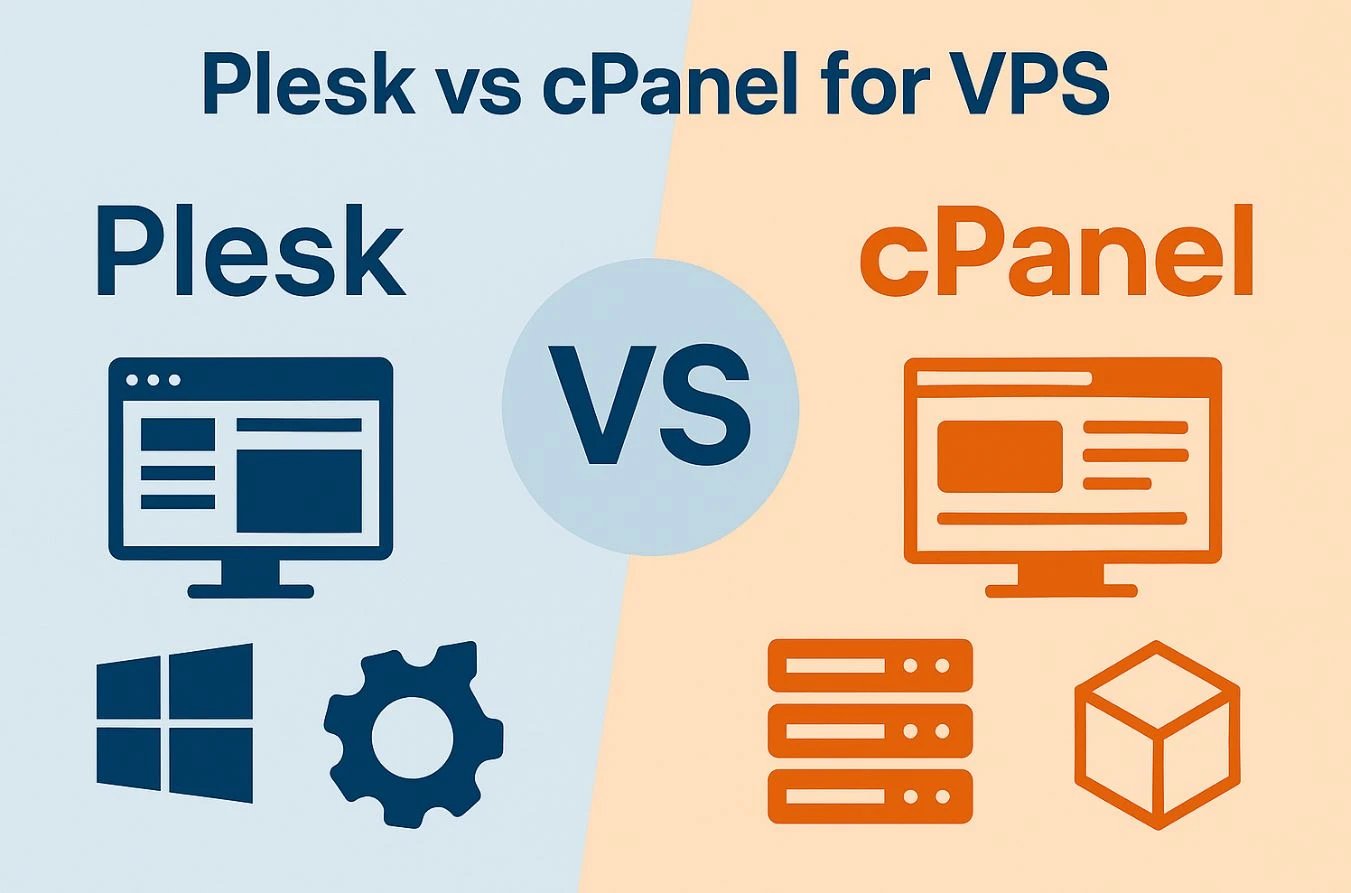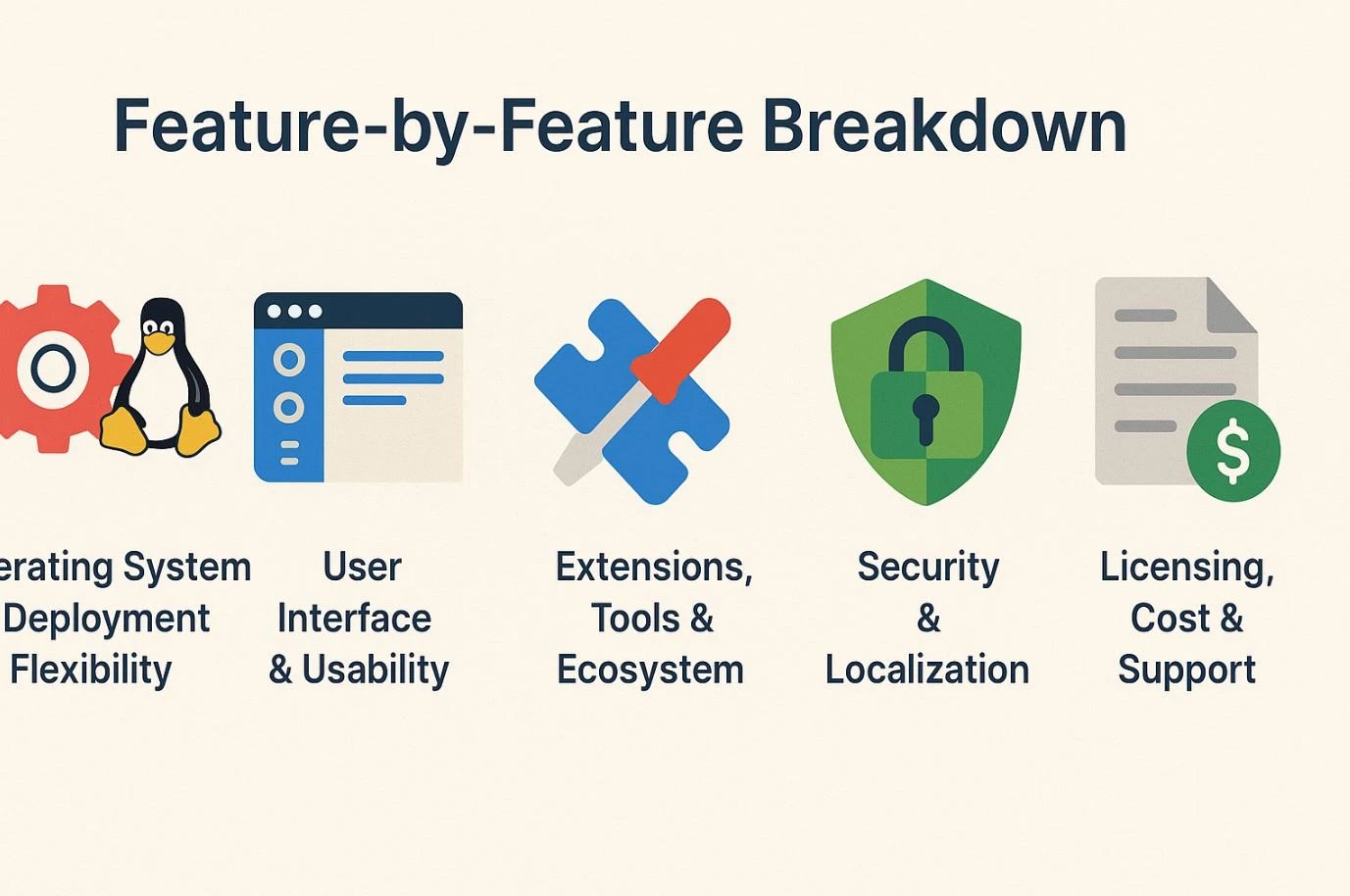The choice of control panel can either make or break an experience in managing one's VPS. Among the best options, Plesk and cPanel seem to be the most widely used, each providing, for example, developers, resellers, and WordPress users with their distinct advantages.
Plesk wins with support for Windows, a modern UI, and an in-built toolkit for WordPress, though overall resale-friendly cPanel is better documented and more widely adopted. In the following sections, Plesk vs cPanel VPS will be discussed, delineating their usability, security, extensions, pricing, and scalability, to give you insight into which best suits your hosting needs.
✨ What are Plesk and cPanel?
Plesk is an up-to-date web hosting control panel that is handy for server management under either Linux or Windows VPS environments. Plesk has an elegant and modern dashboard set up with auto-fighting tools for website administration, email accounts, DNS settings, databases, etc. Featuring another huge plus of WordPress Toolkit, it allows one-click installation, update, and hardening of WordPress sites against security threats.
Plesk application marketplace, cloud backup integrations (Dropbox, AWS), and multilingual support make Plesk an attractive option for developers, agencies, and businesses that prioritize flexibility and ease of use.
cPanel, in contrast, being a Linux-only control panel, is used together with WHM (Web Host Manager) to manage servers fully and at the account level. Widely considered the industry standard, especially amongst resellers and hosting providers, cPanel offers extensive documentation that spans a broad plugin ecosystem, including app installers like Softaculous.
It has an interface that looks older in comparison to Plesk, but it is highly reliable and scalable, and is popular amongst shared hosting and VPS hosting companies.
If you’re interested in exploring the best control panel for VPS beyond these two, you can also review cPanel alternatives
🔑 Key Differences at a Glance

At first glance, both Plesk and cPanel serve the same purpose: simplifying VPS and web hosting management. However, their differences in OS compatibility, usability, security, and pricing make each one better suited for specific user scenarios. The table below highlights the most important distinctions to help you evaluate which control panel aligns with your VPS needs.
|
Feature |
Plesk |
cPanel |
|
OS Compatibility |
Supports Linux + Windows |
Linux-only |
|
Interface & Usability |
Sleek, modern UI with intuitive navigation |
Classic UI, steeper learning curve for beginners |
|
Plugin/Extension Ecosystem |
Built-in marketplace with a wide range of extensions |
Strong plugin ecosystem (e.g., Softaculous, app installers) |
|
Resource Usage |
More efficient on smaller VPS setups |
Reliable but slightly heavier on resources |
|
Multi-site / Reseller Features |
Strong WordPress toolkit, easy multi-site management |
Highly popular with resellers and hosting providers |
|
Support & Documentation |
24/7 free support + multilingual docs |
Extensive documentation, active community |
|
Price / Licensing |
Flexible plans generally have a lower entry cost |
Licensing tied to account numbers can get expensive |
This quick comparison shows that Plesk offers more flexibility (especially with Windows hosting), while cPanel’s reseller ecosystem makes it a stronger choice for hosting providers. Your decision largely depends on whether you value modern usability or industry-standard reliability.
For users who want to go deeper into how other panels compare with cPanel, our CyberPanel vs cPanel guide highlights another popular choice in the VPS ecosystem.
⚙️ Feature-by-Feature Breakdown
While the quick comparison table highlights the essentials, understanding Plesk vs cPanel for VPS requires a deeper look at their individual strengths. Each panel has unique advantages depending on whether you prioritize cross-platform flexibility, usability, WordPress management, reseller features, or cost-efficiency. Below, we’ll break down their performance feature by feature, so you can match the right control panel to your hosting goals.

🖥️ Operating System & Deployment Flexibility
One of the biggest differences is OS support. Plesk runs on both Linux and Windows, making it the go-to choice for businesses relying on Microsoft technologies like ASP.NET or MSSQL. cPanel, however, is Linux-only, which limits its deployment flexibility but ensures tight optimization and compatibility with the Linux ecosystem. For VPS users who require cross-platform options, Plesk clearly takes the lead.
Plesk’s ability to run on both Linux and Windows makes it a natural fit for enterprises that rely on Microsoft stacks. To better understand these strengths, see our breakdown of Plesk VPS Hosting Benefits.
🎨 User Interface & Usability
Plesk is designed with a sleek, modern interface that appeals to beginners and professionals alike, offering clean navigation and a mobile app for on-the-go management. cPanel, while reliable, still maintains its classic, text-heavy layout that may feel outdated for some users. For those new to VPS management, Plesk often feels more intuitive, whereas experienced Linux admins may prefer cPanel’s traditional approach.
🛠️ Extensions, Tools & Ecosystem
Plesk comes with an integrated extension marketplace offering cloud backups, developer tools, and productivity add-ons. Its standout feature, the WordPress Toolkit, allows advanced WordPress management in one place. cPanel, on the other hand, shines with a robust plugin ecosystem like Softaculous and third-party integrations that support hundreds of applications. Both panels support a wide range of tools, but the choice often depends on whether you prioritize WordPress workflows (Plesk) or app diversity (cPanel).
🔐 Security & Localization
Security is a core strength of Plesk, offering built-in tools like fail2ban, server health monitoring, and advanced SSL management. It also supports multilingual interfaces, making it a global-friendly option. cPanel relies more on third-party security plugins but benefits from its vast documentation and community-tested hardening practices. In terms of localization and built-in safeguards, Plesk holds a stronger edge.
💰 Licensing, Cost & Support
Pricing is often a deciding factor between the two. Plesk offers flexible licensing based on the number of domains, which can be more cost-effective for small to medium VPS setups. cPanel’s licensing has become more expensive over time, with pricing tied to the number of accounts, a challenge for budget-conscious users. On the support side, Plesk provides 24/7 free assistance, while cPanel relies heavily on its extensive documentation and community forums, though premium support is available at extra cost.
📌 Which Control Panel Suits Your VPS Use Case?
Choosing between Plesk and cPanel often depends on the type of VPS user you are and the tasks you need to prioritize. Each control panel offers unique strengths that make it better suited for specific scenarios.
-
Windows VPS users & .NET developers → Plesk (because it supports both Linux and Windows, making it ideal for Microsoft-based stacks).
-
Beginners & small business owners → Plesk (thanks to its modern, intuitive UI and built-in WordPress Toolkit).
-
WordPress-heavy environments → Plesk (advanced WordPress management tools, staging, and security features).
-
Resellers & hosting providers → cPanel (industry-standard with WHM integration and strong account-level management).
-
Linux power users → cPanel (stable, widely supported, and optimized for Linux environments).
-
Cost-sensitive small VPS setups → Plesk (flexible licensing that can be cheaper at smaller scales).
-
Large-scale multi-account environments → cPanel (stronger ecosystem for resellers, though higher licensing costs).
As you can see, Plesk is generally more flexible and beginner-friendly, while cPanel dominates in reseller and Linux-centric environments. The right choice depends on whether your priority is ease of use and flexibility or scalability and industry-standard tools.
For developers or businesses leaning toward Plesk, you can explore tailored plans through our Plesk VPS Server.
✅ Quick Decision Checklist
If you’re still unsure whether Plesk or cPanel is the right choice for your VPS, this checklist provides a quick way to match your needs with the ideal control panel. Use it as a snapshot guide before making your final decision.
|
Scenario |
Best Choice |
Why |
|
Running a Windows VPS |
Plesk |
Only Plesk supports Windows alongside Linux |
|
Need a modern, beginner-friendly UI |
Plesk |
Sleek interface, easier for non-technical users |
|
Managing WordPress-heavy sites |
Plesk |
Advanced WordPress Toolkit with staging & security |
|
Running a reseller or hosting business |
cPanel |
WHM integration, account-level management |
|
Prefer Linux-only environments |
cPanel |
Optimized, reliable, industry-standard option |
|
On a tight VPS budget |
Plesk |
Flexible domain-based licensing, lower entry costs |
|
Handling large-scale multi-accounts |
cPanel |
Strong ecosystem, proven reseller scalability |
This table makes it clear that Plesk excels in flexibility and WordPress management, while cPanel remains the powerhouse for Linux hosting and resellers. Your VPS priorities should guide which control panel will deliver the smoothest experience.
Conclusions
A Plesk control panel and a cPanel control panel for VPS hosting are two very aggressive control panels. Each of them excels in various fields. Plesk offers the most modern UI, WordPress Toolkit, and Windows support, making it extremely easy for beginners, developers, and businesses trying to implement flexibility; whereas, cPanel is the name in Linux hosting and for resellers, being backed by integrated WHM and a very wide support system.
So if your preference is ease of use and cross-platform versatility, then you should go for Plesk; otherwise, if tested and proven scalability, along with features friendly to resellers, matter to you, then you should go with cPanel. This way, your VPS environment will be completely aligned with the technical and business requirements you are considering.










